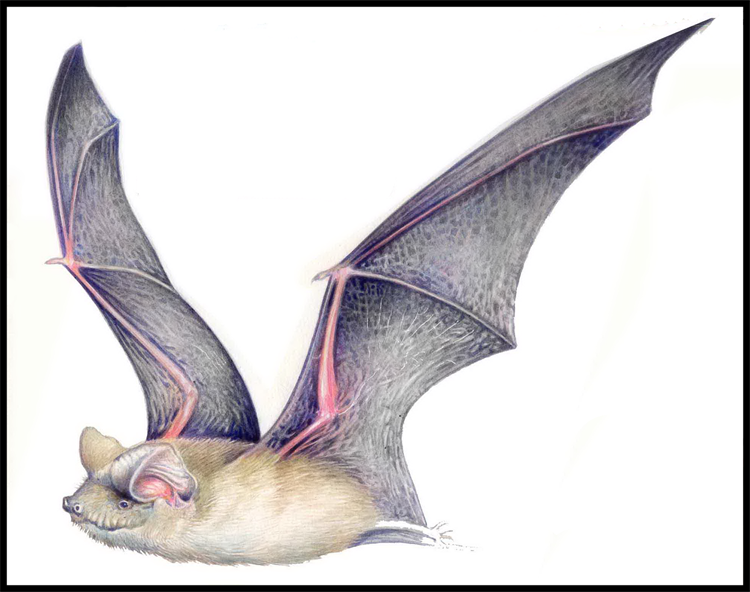Molossidae
Guía de identificación de murciélagos de Chile

La taxonomía sigue las actualizaciones más recientes basadas en Simmons and Cirranello (2020a) y D'Elia et al (2020)
Tadarida brasiliensis (I. Geoffroy, 1824).
Tadbra
| Parámetros | N | Min | Max | Promedio | St.Dev | 10% | 25% | 75% | 90% |
| Dur | 10,624 | 2.00 | 31.53 | 9.88 | 4.13 | 3.38 | 6.53 | 13.01 | 14.51 |
| TBC | 10,322 | 2.2 | 3469.1 | 236.8 | 159.4 | 71.4 | 156.0 | 302.8 | 369.6 |
| Fmin | 10,624 | 10.94 | 56.34 | 23.39 | 2.43 | 20.62 | 21.86 | 24.84 | 26.40 |
| Fmax | 10,624 | 18.41 | 66.67 | 29.79 | 7.06 | 22.99 | 24.84 | 33.20 | 40.20 |
| BW | 10,624 | 0.11 | 40.42 | 6.40 | 6.33 | 1.10 | 2.03 | 8.66 | 15.62 |
| Fmean | 10,624 | 15.51 | 59.90 | 25.78 | 3.26 | 22.07 | 23.49 | 27.67 | 30.17 |
| Fk | 10,624 | 18.08 | 62.50 | 26.66 | 3.75 | 22.73 | 24.28 | 28.47 | 30.59 |
| FCH1 | 10,624 | 8.37 | 28.17 | 12.35 | 1.63 | 10.76 | 11.35 | 13.10 | 13.94 |
| Fc | 10,624 | 16.74 | 56.34 | 24.71 | 3.26 | 21.51 | 22.70 | 26.19 | 27.87 |
| FcH3 | 10,624 | 25.11 | 84.51 | 37.06 | 4.89 | 32.27 | 34.05 | 39.29 | 41.81 |
| Sc | 10,624 | -212.27 | 499.75 | 33.76 | 58.14 | 3.88 | 8.13 | 28.68 | 80.07 |
| Pmc | 10,624 | 0.00 | 152.40 | 19.95 | 20.11 | 3.20 | 6.50 | 26.50 | 46.70 |
Grabado por Chris Corben
|
|
Extraído de la distribución de especies asociadas espacialmente con zonas ecológicas reconocidas para Chile (Ver Martinez et al., 2017 y Pliscoff y Fuentes-Castillo 2011)
|
|
Desde Rodríguez-San Pedro et al., 2016
|
|
Desde el nivel del mar hasta 3500 metros
I.U.C.N.: Preocupación menor Barquez et al., (2015)
Chile: Preocupación menor. DS 06 (2017)
Barquez, R., Diaz, M., Gonzalez, E., Rodriguez, A., Incháustegui, S. & Arroyo-Cabrales, J. 2015. Tadarida brasiliensis. The IUCN Red List of Threatened Species 2015: e.T21314A22121621. https://dx.doi.org/10.2305/IUCN.UK.2015-4.RLTS.T21314A22121621.en.
Canals, M., C. Atala, B. Grossi, J. Iriarte-Díaz, & J. Iriarte-Diaz. 2005. Relative size of hearts and lungs of small bats. Acta Chiropterologica 7:65–72.
D’Elia, G. et al. 2020. Lista actualizada de los mamíferos vivientes de Chile. Boletín del Museo Nacional de Historia Natural, Chile 69:67–98.
DS 06/2017 MMA. Decreto Supremo 06/2017 Ministerio del Medio Ambiente, http://www.mma.gob.cl/clasificacionespecies/decimo-tercer-proceso.htm
Galaz, J. L., J. Y. Vanezuela, A. G. P., and D. R. Martinez. 2009. Orden Quiroptera. Pp. 67-83 in Mamiferos de Chile (A. Munoz-Pedreros and J. Y. Vanezuela, eds.).
III, P. A. H., C. N. Meynard, M. Soto-Gamboa, & W. F. Frick. 2010. Patterns of Species Richness and Activity of Bats among Land-use Types in Southern Chile. Bat Research News. Bat Research News.
Iriarte, A.. 2007. Mamíferos de Chile. Lynx Ediciones, Chile. 1-420.
Mann, G. 1978. Los Pequeños Mamíferos de Chile (marsupiales, quirópteros, edentados y roedores). Gayana. 40: 1-356.
Muñoz, A. E., G. Ossa, T. Zaviezo, & C. Bonacic. 2019. Diversity and foraging activity of bats in cultivated and uncultivated areas in agroecosystems of a Mediterranean-climate hotspot. Neotropical Biodiversity 5.
Rodríguez-San Pedro, A., J. L. Allendes, and G. Ossa. 2016. Updated list of bats of Chile with comments on taxonomy, ecology, and distribution. Biodiversity and Natural History. 2: 18-41.
Simmons, N. B., and A. L. Cirranello. 2020a. Bat Species of the World: A taxonomic and geographic database. www.batnames.org
Tamayo, M., and D. Frassinetti. 1980. Catálogo de los mamíferos fósiles y vivientes de Chile. Boletín del Museo Nacional de Historia Natural de Chile. 37: 323-399.




